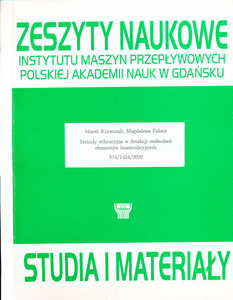Zeszyty Naukowe
Metody wibracyjne w detekcji uszkodzeń elementów konstrukcyjnych
525/1484/2002.Niniejsza monografia zawiera przegląd metod wibracyjnych stosowanych w detekcji uszkodzeń w elementach konstrukcyjnych. Przedstawia aktualny stan wiedzy dotyczącej wibracyjnych metod detekcji uszkodzeń oraz wyniki badań Autorów uzyskane w trakcie realizacji w latach 1999 2001 projektu badawczego finansowanego przez KBN. Opisuje kolejno metody modelowania zmian sztywności konstrukcji w miejscu uszkodzenia, metody wibracyjne wykorzystywane do detekcji uszkodzeń, metody rozwiązywania zadania odwrotnego, tj. poszukiwania parametrów uszkodzenia w oparciu o zmierzone zmiany charakterystyk dynamicznych konstrukcji. Opisane są również metody tradycyjne, sieci neuronowe i algorytmy genetyczne. Praca zawiera opis nowych, zweryfikowanych eksperymentalnie modeli jednowymiarowych elementów konstrukcyjnych z pęknięciami, opracowanych przez Autorów. Nowością tych modeli jest uwzględnienie wpływu uplastycznienia wierzchołka pęknięcia na zmiany sztywności konstrukcji. Praca zawiera analizę czułości najczęściej spotykanych w literaturze dynamicznych wskazników uszkodzeń. Analizowany jest wpływ błędów pomiarowych, liczby punktów pomiarowych, częstości wymuszeń itp. na możliwość wykrywania małych pęknięć. Całośc pracy podsumowano informacjami na temat kierunków rozwoju metod wibracyjnych w detekcji uszkodzeń
The aim of this work is to perform currently used vibrational methods for damage detection in structures. The monograph presents the actual state of the art. in the field of damage detection. Also the results of calculations obtained by authors during canying out the scientific research programme financed by State Committe for Scientific Research in years 1999 - 2001 are included. The work presents methods of modelling the changes in structure's flexibility due to crack appearance, vibrational methods used for damage detection, methods used for inverse problems (finding the parameters of the failure from measured dynamic characteristics). There are also traditional, non-inverse methods described, which include neuronal nets and genetic algorithms. The work includes also a description of the new, experimentally verified one-dimensional constructional elements with cracks, elaborated by authors. The main innovation implemented into described models is taking into account the influence of plasticity zone around the crack tip for the global flexibility of the structure. Additionally in the monograph results of the analysis of sensitivity of dynamic damage indicators, known from literature, are presented. Moreover influence of measurement errors, a number of measurement points, an excitation frequency, etc on the possibility of damage detection was analysed. The work is summarised with information about the possible directions for future damage detection techniques





















